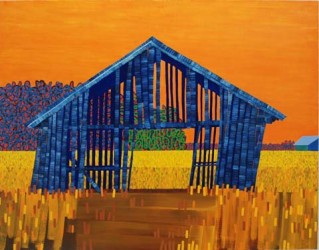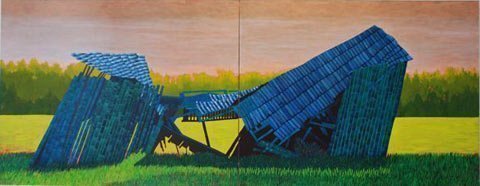Elina Försti
MAALAUKSIA
1.4.2009 — 19.4.2009Evijärveläissyntyisen Elina Förstin latomaalauksia on joskus luonnehdittu viileän älyllisiksi. Ilmaisulla on haettu eroa Nelimarkkalaisiin panoraamamaisemiin, joista on totuttu löytämään pohjalaisuuden ja agraariyhteiskunnan ihailua. Moderni aivotutkimus ei tue mustavalkoista jakoa järkeen ja tunteisiin, mutta on selvää että Förstin rinnastaminen kanonisoituihin latomaalareihin on perusteltua. Elina Försti tuntee klassikot, mutta ei tyydy niiden toisintamiseen, vaan etenee omaan suuntaansa haastaen ja leikitellen.
Maalaustaiteen ansiosta Pohjanmaa on yksi kansallismaisemistamme: romanttisen, ”puhtaan” ihmistyön jäljet lakeuksilla, yllään hartautta vaativa suuri taivas. Ihannoitu latomeri oli todellisuutta lopulta vain joidenkin vuosikymmenien ajan. Tarpeettomiksi muuttuneiden ja purkamiselta säästyneiden heinävarastojen kohtalo on ollut hidas mutta vääjäämätön rapistuminen ja tuho. Menneisyyden katoamisen symboleiksi 2000-luvun pohjalaisladot ovat helposti tarjolla oleva valinta.
Tapa jolla Elina Försti latojaan käsittelee on kuitenkin kaikkea muuta kuin ilmeinen. Maalauksista ei löydä paatosta, niiden väri-iloittelu ei kerro epätoivosta menneen häviämisen edessä, vaan uteliaisuudesta sen edessä, mihin on mahdollista päätyä.. Elinkaarensa loppupäässä ladot ovat Förstille abstraktiin viekoittelevia läpinäkyviä rakennelmia. Periksi antaneiden ja hylättyjen rakennusten alkuperäinen käyttötarkoitus jää lopulta sivuseikaksi: se mitä luetaan rivien, hirsikerrosten välistä, on lopulta olennaisempaa kuin se mikä katoaa.
Millaista sielunmaisemaa Elina Försti töissään peilaa? Panoraamanomaiset maisemat puuttuvat, valmista oppirakennelmaa ei tarjota. Yhtenäistä, totuttua tarinaa ei – ehkä – ole. On opittava luopumaan saavuttaakseen uutta. Kiinnostava löytyy tästä hetkestä. Läsnä on leikki, prosessi jossa taiteilija on kysynyt maalaukselta, mitä annettavaa sillä voi vielä tekijälleen olla – sen asemesta että taiteilija tyytyisi pelkästään tekemään kaikkensa maalauksen eteen. Tämä vuoropuhelu on johtanut kehitystä latoaiheen ympärillä: mukaan on tullut vaikutteita pointillismista, pelloissa ja laudoituksissa elää viivakoodi. Förstin latotöille alusta saakka ominainen tekstiilitaiteen vaikutus, värien vietäväksi heittäytyminen ja sattumienkin ohjaama maalaamisen ilo ovat läsnä.
Teksti: Raimo Pesonen
Elina Försti (s.1971) asuu ja työskentelee Alajärven Luoma-aholla. Hän on valmistunut taidemaalariksi Vapaasta taidekoulusta 2000 ja tekstiiliartenomiksi Kuopion Käsi- ja taideteollisuusakatemiasta 1996. Oman taiteellisen työnsä ohessa Försti on toiminut sivutoimisena taideaineiden opettajana vuodesta 2000 lähtien lähialueiden kansalaisopistoissa Järviseudulla ja Keskipohjanmaalla. Hän on opettanut taidetta lapsille, aikuisille ja erityisryhmille.
Kuvat Nina Nojonen (paitsi Aila Leppikangas kuvannut Haimarin)
Elina Försti
paintings
1.4. – 19.4.2009
The barn paintings by Elina Försti, who was born in Evijärvi, have sometimes been characterized as coolly intellectual. The expression aims to differentiate her work from the Nelimarkka panoramic landscapes that typically portray admiration of the Ostrobothnian way of life and the agrarian society. Modern brain studies do not support a black and white division into sense and sensibility, but paralleling Försti to canonized barn painters is obviously justified. Elina Försti is familiar with the classics, but instead of reproducing them she is going in her own direction in a challenging and playful way.
Due to the art of painting, Ostrobothnia is one of our national landscapes: the open plains with the traces of romantic and ”pure” work of man under a great sky that is demanding devoutness. In the end, the idealized ocean of barns was reality only for a couple of decades. The destiny of these now purposeless hay barns that have escaped demolition has been a slow but inevitable deterioration and destruction. As symbols of the disappearing past, the Ostrobothnian barns of the 21st century are an easily available choice.
The way Elina Försti approaches the barns in her paintings is, however, anything but obvious. The paintings have no pathos, their joyful colours do not reflect despair in the face of the disappearing past but curiosity in what lies ahead. The barns that are at end of their life cycle represent to Försti transparent structures that entice her to paint abstract art. In the end, the original purpose of these surrendered and abandoned barns remains less important: what is read between the lines, the layers of log, is eventually more essential than what disappears.
What is the landscape of the soul that Elina Försti reflects in her work? There are no panoramic landscapes, no completed learning structure. There is – perhaps – no uniform, familiar story. One has to learn to give up in order to achieve something new. The interesting is found in this moment. A play, a process, is present in which the artist has asked the painting what more it has to give instead of doing everything for the painting. This dialogue has been leading the development around the barn theme: it now includes some influences from pointillism; the fields and the panelling embody a bar code. The influence of textile art, the playing with colours, and the joy of painting are present that have been characteristic of Förstis’s barn paintings from the beginning.
Text: Raimo Pesonen
Elina Försti (b. 1971) lives and works in Luoma-Aho, Alajärvi. She has graduated as a painter from Free Art School in 2000 and as a textile designer from Kuopio Crafts and Design School in 1996. In addition to her artistic work, Försti has worked as a part-time art studies teacher in adult education centres of Lake District and Central Ostrobothnia. She has taught art to children, adults and special groups.
Photos Nina Nojonen (except Haimari by Aila Leppikangas)





